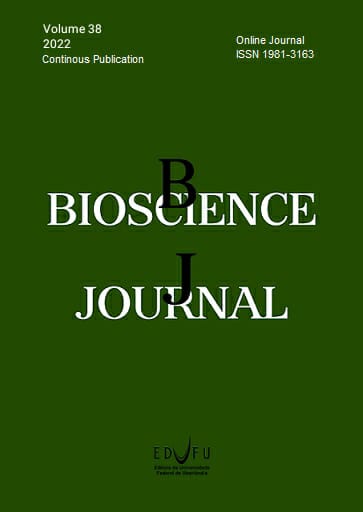Phytosociological survey of weeds in the grapevine
DOI:
https://doi.org/10.14393/BJ-v38n0a2022-53677Keywords:
Cultural practices, Infesting community, Phytosociology, Viticulture, Vitis vinifera L.Abstract
Viticulture is expanding in the state of Espírito Santo, Brazil. Weed management is essential for the crop, so knowing the floristic composition of weeds in the vineyards makes this practice sustainable. This study aimed to evaluate the floristic composition of weed populations in grape crops in two seasons, considering different altitudes. The experiment was performed in four properties located in Santa Teresa, ES, Brazil, two of which were at altitudes above 500 m of and two below 500 m, in the winter (2018) and summer (2019) seasons. Weeds were identified with the square inventory method. The phytosociological analysis was based on absolute and relative parameters of frequency, density, dominance, importance value index, and relevance index, besides the diversity, evenness, and similarity indices. Fifty species, 41 genera, and 19 families were identified. The most representative families regarding the number of species were Asteraceae, Poaceae, and Malvaceae. In properties with higher altitudes, the species with the highest IVI was Pilea microphylla (L.) Liebm., in both seasons. In properties with lower altitudes, the highest IVI values were found for Malvastrum coromandelianum L. in the winter and Commelina benghalensis and Portulaca oleracea L. in the summer. The areas below 500 m of altitude showed the highest diversity and evenness indices. The proximity between the areas in both regions contributed to the increased similarity index. Altitude and time of the year contribute to the composition of the infesting community.
References
ADEGAS, F.S., et al. Levantamento fitossociológico de plantas daninhas na cultura do girassol. Planta Daninha. 2018, 28(4), 705-716. https://doi.org/10.1590/S0100-83582010000400002
ALVARES, C.A., et al. Köppen's climate classification map for Brazil. Meteorologische Zeitschrift. 2013, 22(6), 711–728. https://doi.org/10.1127/0941-2948/2013/0507
BRINGHENTI, A M. Manual de identificação e manejo de plantas daninhas em cultivos de cana-de-açúcar. 1st.ed. Juiz de Fora: Embrapa gado de leite, 2010.
CAGLIONI, E., et al. Altitude e solos determinam variações abruptas da vegetação em gradiente altitudinal de Mata Atlântica. Rodriguésia. 2018, 69(4), 2055-2068. https://doi.org/10.1590/2175-7860201869436
CARDOSO, A.D., et al. Levantamento fitossociológico de plantas daninhas na cultura da mandioca em Vitória da Conquista, Bahia. Bioscience Journal. 2013. 29(5), 1130-1140.
CASTRO, L.L.F., SEDIYAMA G.C. and GUIDONI,.A.L. Probabilidade de precipitação mensal e anual para o Estado do Espírito Santo. Cariacica: EMCAPA. Boletim Técnico. 1981. Available from: https://biblioteca.incaper.es.gov.br/digital/handle/item/1196
CORDEIRO, A.A.C. 2017. Influência da Altitude sobre a Composição Florística e Diversidade de Plantas da Serra do Caparaó, Sudeste Brasileiro. Viçosa: Universidade Federal de Viçosa, 2017. Dissertação de Mestrado.
ERASMO, E.A.L., PINHEIRO, L.L.A., and COSTA, N.V. Levantamento fitossociológico das comunidades de plantas infestantes em áreas de produção de arroz irrigado cultivado sob diferentes sistemas de manejo. Planta Daninha. 2004, 22(2), 195-201. https://doi.org/10.1590/S0100-83582004000200004
ESTEVES, J. Produção de uva e vinho é destaque no Espírito Santo, 2018. Available from: https://www.es.gov.br/Noticia/producao-de-uva-e-vinho-e-destaque-no-Espirito-Santo.
FABRICANTE, J.R. Estrutura de Populações e Relações Sinecológicas de Cnidoscolus phyllacanthus (Müll. Arg.) Pax & L. Hoffm. no Semi-Árido Nordestino. Areia: Universidade Federal da Paraíba, 2007. Dissertação de Mestrado.
GAZZIERO, D.L.P., et al. Manual de identificação de plantas daninhas da cultura da soja. 2nd ed. Londrina:Embrapa Soja, 2015. Available from: http://ainfo.cnptia.embrapa.br/digital/bitstream/item/126196/1/manual-de-identificacao-de-plantas-daninhas.pdf
HAMMER, Ø., HARPER, D.A.T., and RYAN, P. D. PAST: palaeontological statistics software package for education and data analysis. Palaeontologia Electronica. 2001, 21(4), 1-9.
INCAPER. Programa de Assistência Técnica e extensão rural PROATER 2011-2013: Planejamento e programação de ações, Vitória-ES: Secretaria de Agricultura, Abastecimento, Aquicultura e pesca - Governo do Estado do Espírito Santo, 2011. Available from the Internet: http://biblioteca.incaper.es.gov.br/digital/bitstream/item/2028/1/BRT-proater-extremonorte.pdf
JONGMAN, E. Data analysis in community and landscape ecology. New York: Cambridge University Press, 1995.
LIMA, L.K.S., et al. Fitossociologia de plantas daninhas em pomar de goiabeiras em diferentes épocas de amostragem. Revista Biociências. 2015, 21(1), 45-55.
LORENZI, H. Plantas daninhas do Brasil: terrestres, aquáticas, parasitas e tóxicas.3rd ed. Nova Odessa: Plantarum, 2000.
MAGURRAN, A.E. Measuring biological diversity. Oxford: Blackwell Science, 2004.
MELO, L.M.R. Panorama Da Produção De Uvas E Vinhos No Brasil. Boletim Técnico – Campo e Negócios, 2017. Available from: https://ainfo.cnptia.embrapa.br/digital/bitstream/item/159111/1/Mello-CampoNegocio-V22-N142-P54-56-2017.pdf
MOURA FILHO, E.R., MACEDO, L.P.M., and SILVA, A. R. S. Levantamento fitossociológico de plantas daninhas em cultivo de banana irrigada. Holos. 2015, 2(1), 92-97. https://doi.org/10.15628/holos.2015.1006. ISSN 1807-1600
MUELLER-DOMBOIS, D., and ELLEMBERG, H.A. Aims and methods of vegetation ecology. 7th ed. New York: The Blackburn Press, 1974.
OLIVEIRA, A.R., and FREITAS S.P. Levantamento fitossociológico de plantas daninhas em áreas de produção de cana-de-açúcar. Planta Daninha. 2008, 26(1), 33-46. https://doi.org/10.1590/S0100-83582008000100004
OLIVEIRA M. F., and BRINGHENTI, A. M. Controle de Plantas Daninhas Métodos físico, mecânico, cultural, biológico e alelopatia. Brasília: Embrapa, 2018. Available from:http://www.infoteca.cnptia.embrapa.br/infoteca/handle/doc/1103281
RODRIGUES, A.C.P., et al. Períodos de interferência de plantas daninhas na cultura do sorgo. Planta Daninha. 2010, 28(1), 23-31. https://doi.org/10.1590/S0100-83582010000100003
RODRIGUES, A.P.M.S., et al. Levantamento fitossociológico de plantas daninhas na cultura da cenoura em monocultivo e consorciada com rabanete. Revista Verde Agroecologia Desenvolvimento Sustentável. 2016, 11(1), 73-77. https://doi.org/10.18378/rvads.v11i1.4450
SANTOS, M.M., et al. Identificação de potenciais plantas hospedeiras alternativas de Xanthomonas campestrispv. viticola. Ciência Rural. 2014, 44(4), 595-598. https://doi.org/10.1590/S0103-84782014000400003
SAPORETTI JUNIOR, AW., MEIRA NETO,J.A.A., and ALMADO R. P. Fitossociologia de cerrado sensu stricto no município de Abaeté-MG. Revista Árvore. 2003, 27(3), 413-419. https://doi.org/10.1590/S0100-67622003000300020
SOARES, M.B.B., et al. Plantas daninhas em área de reforma de cana crua com diferentes manejos do solo e adubos verdes em sucessão. Agro@mbiente. 2012, 6(1), 25-33. https://doi.org/10.18227/1982-8470ragro.v6i1.683
Downloads
Published
Issue
Section
License
Copyright (c) 2022 Ronaldo Luiz Rassele, Silvério de Paiva Freitas, João Nacir Colombo, Marcelo Rodrigo Krause, Heitor Barth, Henrique Teodoro Barth

This work is licensed under a Creative Commons Attribution 4.0 International License.





